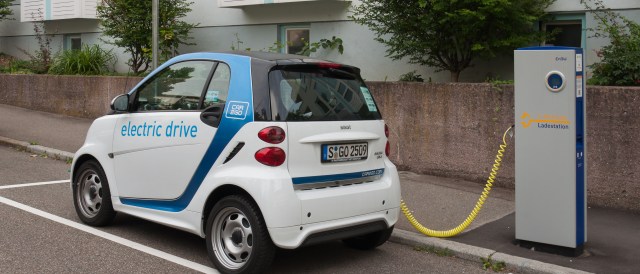Germany is a bit of a laggard when it comes to electric cars, and the Energiewende has not focused on the transport sector enough. But it seems like this is about to change. Craig Morris investigates.

Carsharing companies have started to embrace electric mobility in Germany, but it has remained a niche technology so far. (Photo by Julian Herzog, CC BY 3.0)
Around eight years ago, I made an interesting discovery as the editor of a magazine on energy efficiency: Germany consumed less electricity for electric mobility than it did for devices on standby. The country had very few electric cars at the time, but still: from high-speed trains down to local trams, less power was consumed than by coffee machines, etc. that were not even on.
The comparison says something about standby (which has improved greatly since thanks to eco-design) but also about the efficiency of electric mobility. In 2007, the Germany Solar Mobility Association calculated that cutting fuel consumption in half with a million electric cars by 2020 would only raise power demand by 10 percent (article in German). The Association’s work was so compelling that the government officially took up the proposed target of a million electric cars by 2020.
But progress has been slow: only 12,156 cars are electric out of a fleet of 43.9 million in Germany.
Now, it seems that the German government is poised to make some changes towards meeting that goal, which is in jeopardy (report in German). In September, German Transportation Minister Alexander Dobrindt and Environmental Minister Barbara Hendricks published an electro-mobility bill (in German). It will encourage communities to set aside parking spaces near charging stations for electric vehicles, provide these parking spaces for free, and open some bus lanes for electric cars. That idea was further reinforced in the climate package announced on Wednesday, December 3.
But not everyone is happy. The Greens pointed out that these proposals would create privileged zones for expensive electric sedans and SUVs, neither of which are particularly environmentally friendly even when they are electric. And Verkehrsclub Deutschland, a group that calls for environmentally friendly and sustainable mobility, complains that the recommendations do not add up to a real strategy.
You will have noticed, though, that those proposals have one thing in common: final decisions are left up to local governments. This relegation of competence is typically German, as the government’s stance on fracking and CCS reveal. Still, it is a step in the right direction. And the tax incentives announced on Wednesday will actually cost the government something.
And if you are wondering what the latest figures are for the share of electric mobility in power supply, the Institute of Applied Ecology just provided them. In their study entitled “eMobil 2050” (PDF), the researchers find that public transportation and railway freight will only make up six percent of total demand by 2030 in the scenario investigated. And if cars run on renewable electricity, emissions will drop by nearly 90 percent relative to 1990. The German government itself has also come up with a new report on electro-mobility, in which it praises the US, Norway and France as models to follow (PDF in German).
The maximum amount of power required for electric mobility by 2050 throughout the entire transport sector is estimated to be no more than 150 TWh, merely a quarter of current power demand. That figure could also be cut in half, mainly through sufficiency (essentially, behavioral change).
Germany’s success in transitioning its power sector certainly shows that producing this much extra electricity from renewables is not a challenge. On the contrary, experts have repeatedly explained how electric mobility can help make a power supply based on fluctuating wind and solar production more stable. It’s high time for e-mobility to get going and making sure it runs on renewable power.
Craig Morris (@PPchef) is the lead author of German Energy Transition. He directs Petite Planète and writes every workday for Renewables International.